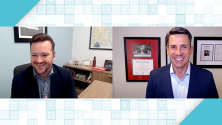As competition for top IT talent becomes increasingly fierce, companies must go above and beyond to attract and retain their best employees. This means designing their workplace for the digital era and managing talent in new ways once they are in the door.
Kristine Dery, research scientist for the MIT Sloan Center for Information Systems Research, has been exploring the evolving digital workplace at the annual MIT Sloan CIO Symposium for the past several years. At this year's event, she will share new findings and explore unique ways CIOs are winning the talent war. Read on for insights from her upcoming talk, taking place on March 24 in Cambridge, MA.

The Enterprisers Project (TEP): At the 2016 MIT Sloan CIO Symposium, you talked about redesigning the digital workplace and said that providing a highly collaborative work environment for employees was the lynchpin of success in the digital age. In 2017, how has the digital workplace evolved?
 Dery: Most companies have realized that designing workplaces where people can excel is about more than just changing the spaces where work is done. They are now focused on the technologies, the social networks, and the leadership practices that build really great employee experiences. This has not been easy for most firms. It requires building a focused leadership team that is constantly looking for the speed bumps that make work hard and then using a range of humans and machines to address them. Those companies that are devoting the senior leadership resources to managing the digital workplace are reaping significant improvements to performance over their competitors. This is no longer a “nice to have;” it is critical to success in the digital era.
Dery: Most companies have realized that designing workplaces where people can excel is about more than just changing the spaces where work is done. They are now focused on the technologies, the social networks, and the leadership practices that build really great employee experiences. This has not been easy for most firms. It requires building a focused leadership team that is constantly looking for the speed bumps that make work hard and then using a range of humans and machines to address them. Those companies that are devoting the senior leadership resources to managing the digital workplace are reaping significant improvements to performance over their competitors. This is no longer a “nice to have;” it is critical to success in the digital era.
TEP: What are the unique ways companies are going above and beyond to attract IT talent?
Dery: We are seeing new approaches to attracting, employing, and retaining talent as companies compete for top talent, particularly in digital where skills are in high demand. Companies are facing the challenges of combining an FTE workforce with contingent workers. We have found that these hybrid workplaces are differentiated based on whether their approach to managing talent is transactional (i.e. based on an orchestrated approach of matching tasks with skill requirements and hiring to fill gaps) or more relational (i.e. based on a curating work environment with employment relationships aimed at building mutual value for both the organization and the employee).
Orchestrated approaches are typically found in more traditional organizations (such as many banks and insurance companies) that have been built on management approaches where career structures, training programs, reward systems have been built around a predominantly FTE workforce. These companies find attracting high performing talent increasingly difficult. As these organizations are forced to engage a more contingent workforce, they face challenges around issues such as onboarding, cultural embeddedness, consistency of pay and reward structures, and knowledge sharing.
Many of the digitally born companies, or those who have taken a leading position around digital, are facing very different challenges. They are engaging with employees in a more curated way, and their challenge is more around retention than attraction. Their organizations are natural homes for those with high-level digital skills. But the challenge is keeping this talent engaged, with so many opportunities for them to choose from, particularly in the alluring world of start-ups.
Increasingly, we are seeing more curated models where employee engagement is more flexible and fluid. We see organizational boundaries becoming more porous with employees able to work in co-working spaces; build their start-ups within the mother-ship business environment (in labs, or garages within the home organization designed to enable talent to have a foot in both camps); or take time out to explore other opportunities with a loose rein back to the home company. These are very different talent management models, with significant implications for the design and management of the digital workplace.
TEP: What are the biggest barriers to collaboration in most workplaces today?
Dery: Systems and leadership have really shown up as critical issues to build higher levels of collaboration in organizations. It is critical, particularly in large organizations, that people can share knowledge, draw on great data to make decisions from multiple sources, and be flexible in where and when they work. However, one of the distinguishing factors of companies that excel in collaboration is a more responsive style of leadership – one that is comfortable with openness and understanding of the demands of the digital world. Most large companies have become great through command and control models, but the world of digital requires a leadership style that is more comfortable with experiments, learning, adapting, and working across traditional hierarchies and business silos. Leaders need to create the fertile ground for employees to connect with each other, with ideas, with the organization, and with broader stakeholders. This requires a more dedicated, iterative approach to the workplace, to enable constructive and informed collaboration that extends beyond traditional boundaries.
TEP: Why should improving the digital workplace be high on a CIO’s priority list? What can CIOs do to combat talent issues within the IT organization specifically?
Dery: The digital workplace provides the fertile ground for employee experience (EX). Our research finds a positive correlation between EX and customer experience (CX), innovation, and profitability. We measure EX as a combination of desirable employee behaviors and work complexity (i.e. how hard is it to get things done). In other words, EX is about how easy or hard it is for me to be the very best that I can be.
Those companies who focus on building great EX also find value in higher levels of CX, and see much more innovation (both internal and customer-facing.) Also, their profits were significantly higher than companies where the experience of employees was not so great. A big part of delivering the capabilities required to enhance EX is the digital technologies and capabilities of the workforce. This must be a major focus for CIOs as they allocate resources, assess risk, and drive changes to the way work is done. Building great workplaces where employees are able to really excel at their work both attracts and retains key talent.







